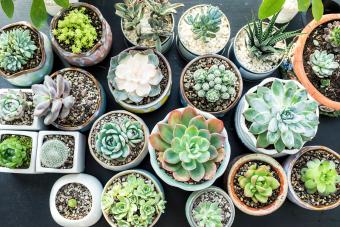
Green roofs insulate a building by reflecting the summer sun away from the structure and by helping hold in the heat in winter. Not just any plant will work in the extreme environment of a roof plant, however. Choosing plants for a green roof means choosing those that are up to the task of making the roof part of the living landscape.
Succulents for a Green Roof
Rooftop vegetation is exposed to intense heat, drying winds, extreme cold, and must be able to thrive in just a few inches of soil. Of all the plants in the world, succulents offer the greatest variety of species that are suitable for a rooftop environment.
Succulents will thrive in soil as shallow as two inches, making them perfect green roof plants.
Sedums
Also known as stonecrop, this large and diverse genus contains dozens of species suitable for a living roof, most of which are low-growing groundcovers. Choose from one of the following selected for their range of leaf color:
- Orange stonecrop (Sedum kamtschaticum) stays four to six inches tall and has green foliage, bearing yellow-orange flowers in summer.
- Gold moss stonecrop (Sedum sarmentosum) is evergreen with a bright yellow coloration in summer.
- Two-row stonecrop (Sedum spurium) is deciduous, with medium green leaves that turn a magenta color when cold weather arrives.
- Golden sedum (Sedum kamtschaticum) grows to around nine inches tall, and is absolutely covered with bright yellow, star-shaped blooms in summer.
- White stonecrop (Sedum album) is a low-growing sedum that blooms in early summer, when the tiny white flowers almost look like snow.
- Blue carpet sedum (Sedum hispanicum) has purple-tinged blue foliage and stays under 4 inches in height.
- Widow's cross (Sedum pulchellum) is an annual sedum that grows in fall, overwinters, blooms in spring, sets its seed, and then dies in the heat of summer. This might be a good choice if you have other sedums or plants that can fill in the gaps in summer and fall.
Sedums are virtually maintenance free, requiring just a bit of water to get established and then spreading freely as long as they are in sun or partial shade.
Sempervivum
Sempervivum grow as a tiny succulent groundcover under four inches tall, unless otherwise noted. They are a great complement to sedums, as the foliage has a strikingly different growth habit.
- 'Pacific Blue Ice' makes cool blue rosettes that multiply in a miniature version of themselves - hence their other name, hen and chicks.
- 'Fauconetti' makes for a very unusual green roof plant with silvery hairs that make it look like it is covered in spiderwebs.
- Tree aeonium, or tree houseleek, is a close cousin of the others that resembles a miniature palm tree about 10 to 15 inches tall.
Like sedums, sempervivums require no care to speak of once they're established, but it is important that the soil mix be extremely well-drained.

Groundcovers for a Green Roof
Not all groundovers will work well on a green roof since they either need deeper soil or moist conditions, which doesn't always work well on a roof. The groundcovers listed below tend to be drought-tolerant and will grow well in around two to four inches of soil.
- Cooper's Hardy Ice Plant (Delosperma cooperi) grows one to two inches tall and blooms in summer, forming a carpet of gorgeous magenta daisy-like blooms for around 4 weeks straight. This ground cover is drought tolerant and pollinator-friendly.
- Snow-in-summer (Cerastium tomentosum) is a drought-tolerant ground cover that grows to about four to five inches tall. A carpet of snow-white blooms covers it in late spring and early summer.
Wildflowers for a Green Roof
Succulents are generally the only plants used in the ultra-thin living roofs when covering a large rooftop, as they can survive in as little as two inches of soil. If you design your roof, or even just parts of it, with four to six inches of soil, you can consider some of the following wildflowers.
These are all drought tolerant species, but will need a bit more moisture than the succulents to get them started and should be watered whenever there is more than a few weeks without rain. Otherwise the only care required is to cut back the flower stalks in fall.
While succulents are normally grown from rooted plugs, wildflowers do best from seed.
- Aster (Asteraceae spp.) is one wildflower that is found in craggy, high elevation areas, meaning that it is built for the tough conditions of a green roof and it's deep purple flowers never fail to attract butterflies.
- Yarrow (Achillea spp.) is a mat-forming groundcover with broad white-capped flowers in summer that are also a favorite of butterflies.
- Lanceleaf coreopsis (Coreopsis lanceolata) blooms in early to mid summer with cheerful orangey-yellow flowers that bees and butterflies enjoy.
- Sea thrift (Armeria maritima) grows wild on oceanside cliffs and resembles a small, clumping grass, but is crowned with pink flowers in summer.
- Cinquefoil (Potentilla anserina) is a good option if your roof gets a lot of shade. It's very tolerant of dry conditions, but prefers part to full shade. Cinquefoil blooms are a cheerful, bright yellow, and it blooms in late spring through early summer.

Aromatic Herbs for a Green Roof
Many aromatic herbs are drought tolerant, but these three are also low-growing groundcovers that can survive in just a few inches of soil.
Like the succulents, these herbs need water to get established, as well as in periods of drought. They also benefit from a light shearing each fall, though this is not required.
- Oregano varieties like Kent Beauty grow about six inches tall and fill the air with smell of the Italian countryside.
- Thymetypically stays under four inches in height and is covered in pink flowers for much of the summer.
- Roman chamomile is a highly aromatic groundcover about three inches tall and is so tough it can even tolerate foot traffic.
- Giant hyssop (Agastache foeniculum) has a wonderful anise-like scent, but even better, its pinkish-purple blossoms are magnets for butterflies and other pollinators.
To cover a large roof area with groundcover herbs, it's best to buy them as small plugs to get the most bang for your buck.

Structural Requirements for a Green Roof
Not every roof can be converted to a green roof without making some structural improvements to ensure the house can support the added weight of the soil and plants. However, there are more and more green roof companies springing up every year who can help you decide if this is the right approach for you.
Even if you don't want to tackle the massive project of converting your home's entire rooftop to a living garden, you can still experiment on a small scale with a shed, gazebo or even just a tiny birdhouse using the right plants.
Maintaining a Green Roof
While green roofs are definitely low maintenance, they aren't no-maintenance. There are a few things you'll have to do at least a few times per season to keep your green roof growing its best.
Watering
Watering will be necessary for the first season when plants are getting established, and during any extended periods of drought.

Weeding
Passing birds will deposit weed seeds onto your roof, and the wind will blow additional weed seeds onto it as well. To keep the weeds from taking over the rest of your green roof, you'll have to weed at least a time or two during the growing season.
Pruning
Pruning will only be necessary if you grow things that grow taller, or if you feel that the overall look of your roof garden is starting to get a bit shaggy. At most, this would only have to be done once during the growing season.
A Little Greener
Creating a green roof has great potential to beautify your home and make a unique architectural statement, but it is also good for the environment. By getting to know the plant species that are adapted to the unusual growing conditions of a rooftop, you can plan your own living roof project and help make the world a greener place.







